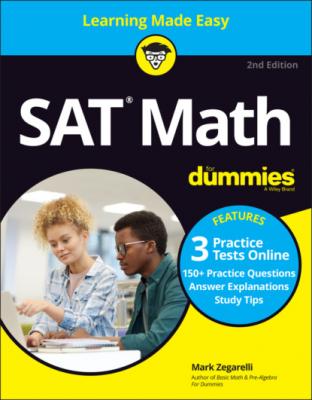SAT Math For Dummies with Online Practice. Mark Zegarelli
Чтение книги онлайн.
Читать онлайн книгу SAT Math For Dummies with Online Practice - Mark Zegarelli страница 13
 story — clearing 500
story — clearing 500
When Jay started studying with me, his goal was very straightforward. A gifted lacrosse player, he was already being recruited by a coach at a college where several of his former teammates were already going. They loved it, and he wanted to join them.
So his high school plan was simple: play hard on the lacrosse field, keep his grades up, and break 1,000 on the SAT.
Jay and I worked together for two or three months, and when he took the test for the first time, he got a 520 in English and a 510 in math. With a 1,030 composite SAT score to work with, the coach advocated for him, and Jay received an early acceptance letter a few weeks later.
As much as he enjoyed working with me on SAT math, he was done. As I write this, he’s the captain of his college lacrosse team.
Shaun’s story — breaking solidly beyond 600
I met Shaun when he was a sophomore, in an SAT class full of all juniors and seniors. He was likeable, quirky, and smart, definitely holding his own in a class full of kids one and two years older than him. His real interest was engineering, and he had a garage full of cool projects in various states of completion.
After the SAT class was done, I started working with him one-on-one over the summer between his sophomore and junior years. He did well on the practice tests, but missed math questions he should have gotten, mostly because he misread the question or made a minor calculation error.
He and I worked together to solidify his skills in the areas of math that most SAT questions focus on: linear functions, linear systems of equations, and quadratic functions. I also encouraged him to spend more time answering the easy-to-medium questions and skipping over the difficult, time-consuming ones.
Shaun thought he was ready to take the SAT for real at the beginning of his junior year. His father thought he needed more practice. I recommended that he take it, if only to resolve their difference of opinion with an actual score. On his first try, he got a 1,340 — 680 in English, 660 in math.
“If you’d like to break 1,400,” I suggested, “we can keep on going.”
But instead, Shaun just kept his grades up, applied to a good engineering program, and got early acceptance. Case closed.
Amy’s story — reaching 700 and beyond
Amy was a bright student, at the top of her class at a very competitive private school. She was already just about killing her SAT practice tests when I began to tutor with her.
We worked together for three or four months, and then she took the SAT with the rest of her class in May of her junior year. On her first try, she got a 750 in English and a 730 in math.
For any other student, that would have been the ballgame. For Amy, getting a 1,480 just about drove her crazy. “Twenty more points! That’s all I need!”
We continued through the summer, and she worked tirelessly. For a day or two, just a couple weeks before the August test, I thought she might crack. “You don’t have to do this.” I explained. “You already have an amazing score. But if you’re going to the SAT Olympics, I’m going to coach you at that level.”
She pressed on, took the test — and got a 1,530 composite, with a 770 in English and a 760 in math. With her grades, extra-curricular activities, and a tremendous common app essay, she was accepted to her first-choice school. I bet you’ve heard of it!
Chapter 2
Review of Pre-Algebra
IN THIS CHAPTER
This chapter provides a review of pre-algebra topics you’ve probably seen before, but maybe half-remember in a fuzzy sort of way. Although some of these concepts may have given you trouble in 7th or 8th grade, you may be surprised how easy some of this stuff seems now — especially if your current math class is Algebra II or Pre-Calculus!
To begin, I discuss five key sets of numbers: natural numbers, integers, rational numbers, real numbers, and complex numbers. Then, you get a review of four ways to represent rational numbers: as fractions, ratios, decimals, and percentages.
After that, I give you a brief review of absolute value, followed by a more in-depth look at radicals (square roots). Then, I provide a clarification of the algebra vocabulary you may recognize but still be unclear about.
I finish up with a look at a short but important list of calculator moves you’ll need to know for the Calculator section of the math SAT.
Sets of Numbers
The SAT Math Test focuses on numbers that fall generally into five sets: natural numbers, integers, rational numbers, real numbers, and complex numbers. Understanding how these sets of numbers differ can be important when answering an SAT question that asks for a solution within a specific set of numbers.
In this section, I give you a brief overview of how these five sets of numbers fit together.
Natural numbers
The first set of numbers you learn as a child are the natural numbers, or counting numbers, which are the positive whole numbers starting at 1 and continuing without end:
When you add or multiply any pair of natural numbers, the result is another natural number. Another way to say this is that the set of natural numbers is closed under both addition and multiplication. However, the natural numbers are not closed under subtraction or division, because when you subtract or divide a pair of natural numbers, the result isn’t always a natural number. For example:
|
|